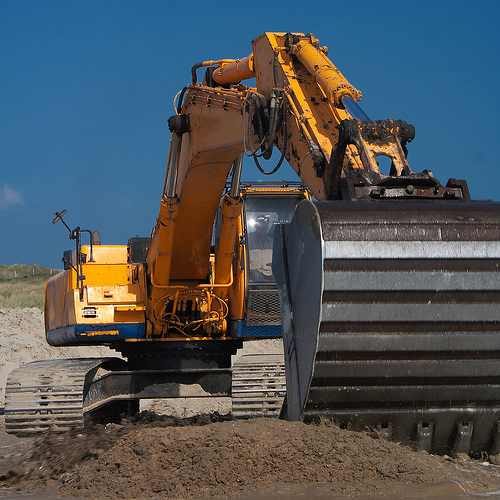 City leaders in Oxford, Ala. have approved the destruction of a 1,500-year-old Native American ceremonial mound and are using the dirt as fill for a new Sam’s Club, a retail warehouse store operated by Wal-Mart.
City leaders in Oxford, Ala. have approved the destruction of a 1,500-year-old Native American ceremonial mound and are using the dirt as fill for a new Sam’s Club, a retail warehouse store operated by Wal-Mart.
A University of Alabama archaeology report commissioned by the city found that the site was historically significant as the largest of several ancient stone and earthen mounds throughout the Choccolocco Valley. But Oxford Mayor Leon Smith — whose campaign has financial connections to firms involved in the $2.6 million no-bid project — insists the mound is not man-made and was used only to “send smoke signals.”
“The City of Oxford and its archaeological advisers have completed a review and evaluation of a stone mound that was identified near Boiling Springs, Calhoun County, Alabama, and have concluded that the mound is the result of natural phenomena and does not meet the eligibility criteria for the Natural [sic] Register of Historic Places,” according to a news release Smith issued last week.
In fact, the report does not conclude the mound is a result of “natural phenomena” but says very clearly it is of “cultural origin.” And while the University’s Office of Archaeological Research does not believe the site qualifies for the National Register of Historic Places, the Alabama Historical Commission disagrees, noting that the structure meets at least three criteria for inclusion: its “association with a broad pattern of history,” architecture “embodying distinctive characteristics,” and for the information it might yield to scholars.
The site is also significant to Native Americans. The Woodland and Mississippian cultures that inhabited the Southeast and Midwest before Europeans arrived constructed and used these mounds for various rituals, which may have included funerals. There are concerns that human remains may be present at the site, though none have been found yet.
United South and Eastern Tribes, a nonprofit coalition of 25 federally recognized tribes from Maine to Texas, passed a resolution in 2007 calling for the preservation of such structures, which it calls “prayer in stone.” Native Americans have held protests against the mound’s demolition, and last week someone altered a sign for the Leon Smith Parkway that runs past the development to read “Indian Mound Pkwy.”
A local resident named Johnny Rollins told the Anniston Star how his Native American grandmother taught him that when she died he could “go to that mountain” to talk to her:
“It seems like it’s taking part of you away,” he said of the demolition. “I always felt I had ties to that there.”
Since the media began reporting on the site’s demolition, city officials have revised their story and are now claiming that dirt from the mound is not being used as fill, despite earlier statements to the contrary. But eyewitnesses say they have seen workers hauling dirt from the mound to the Sam’s Club development.
“I mean really, I went there, saw the giant trucks deliver the earth straight from the mound to the construction site, and I still can’t believe what they are doing,” writes the seventh-generation Alabamian behind the blog Deep Fried Kudzu, where she shares photos from her visit to the site.
‘More prettier’ than an Indian mound
Deepening the development’s controversy is how the contracting has been handled. The force behind the project is Oxford’s Commercial Development Authority, a public board that uses taxpayer money to lure businesses to the area. The CDA owns the land where the mound is located.
Alabama law exempts CDAs from bid requirements, which means contracts can go to whomever the board chooses. A recent Anniston Star investigative series about the CDA revealed among other things that the group has awarded nearly $9 million in contracts since 1994 but has taken bids for none of them.
The newspaper also detailed the financial ties between the CDA, firms it does business with, and Mayor Smith’s political campaign.
For example, the $2.6 million contract for preparing the Sam’s Club site went to Oxford-based Taylor Corp., with the money for that coming in part from the sale of city property to Georgia-based developers Abernathy and Timberlake. Taylor Corp. owner Tommy Taylor, who has received thousands of dollars in city contracts for non-CDA work, donated $1,000 to Smith in 2004 and $1,000 in 2008, while Abernathy and Timberlake donated $1,000 to Smith’s re-election campaign in 2004, the paper reports.
The Anniston Star also found that the CDA paid engineering firm Goodwyn, Mills and Cawood of Montgomery, Ala. $45,000 in engineering contracts for the Sam’s Club project, with part of that money paying for the archaeological study. The firm contributed $500 to Smith in 2004.
An Alabama Ethics Commission official said the relationships could violate state law “depending on facts,” but the mayor said he’s done nothing wrong.
Meanwhile, the controversy over the damaged mound’s fate rages on. After getting an earful from alarmed preservationists, Alabama Gov. Bob Riley (R) forwarded their concerns to the state Historical Commission — but said his office has no intention of getting involved. According to the National Institute on Money in State Politics, Tommy Taylor contributed $1,000 to Riley’s 2006 gubernatorial campaign, while Goodwyn, Mills and Cawood contributed $1,500.
For now, it appears Oxford officials are pressing ahead with the project. As Mayor Smith said in its defense, “What it’s going to be is more prettier than it is today.”
(A version of this story originally appeared at Facing South.)



